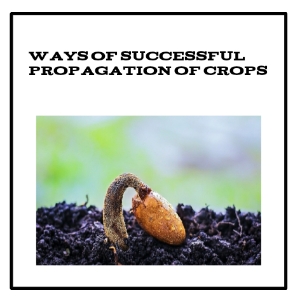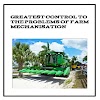What is Propagation?
Propagation is referred to as the multiplication of individual plants into news good plants.In agriculture, there are two types of propagation which includes: sexual and asexual propagation.Sexual propagation is by seed while the asexual propagation is also known as vegetative propagation is by vegetative organs such as plant stems,roots snd leaves cutting.
In order to keep the life of going, farmers should select the strong seed for planting.When farmers is selecting, he needs to consider somethings in order to enhances good result.The factors needs to consider includes
1. Ability of the seed to resist diseases and pest
2. Are they early maturing or late maturing seed?
3. Do they have high yielding or low yielding?
4. Do they resist drought or not?
During selection, farmers should remove the seed that has low quality. Crops that can be propagated by seeds includes tomatoes, okra, grain crops, millet, rice, melon, maize, coconut etc .
In the recent years plant breeders have been working very hard to improve the quality of plant breeds.Breeders have used cross pollination in the production of new varieties of plant.Such achievement has been made in rice ,maize, sorghum, cowpea etc.
Factors Affecting Seed Germination and Behavior
1. Water
2. Age of seed
3. Temperature
4. Depth of planting
5. Food content
6. Light
7. Soil
2. One can easily identify or know the ancestry or parents of the seeds used for planting.
3. Transfer of some good characteristics is possible through breeding.
4. New varieties of seeds can be produced.Now, breeders have produced hybrid maize that matures fast with quality output.
5. Through cross pollination, the ability to improve the quality of seeds to be planted is very high.
2. Pest can easily damage seed in storage meant for planting.
3. Large number of worthless or poor quality seed may be produced, which are not suitable for planting.
4. A great technical know-how is required to achieve the production of high yielding and quality seeds which is not available.
5. Seeds used for propagation are useful food for man.
6. The cost of getting of high quality seeds meant for planting is high which capital is not available.
Asexual propagation
Asexual propagation can be defined as the growing of new plants from parents plants vegetative parts.
Plants that are propagated by asexual means are:
1. Plants that do not produce seeds
2. Plants that produces seed but not too strong for planting
3. Plants that are easier to propagate using vegetative means than using seed which may be too hard or take longer period.
Asexual propagation can be divided into five group namely, cutting, budding, grafting, layering and suckers.
(1) Cutting
When a part of a plant are cut into portions and planted to produce new plants, such as cut portions are called cuttings. Cutting may be from stems or leaves depending on the type of plants being propagated. Plants whose stem produce roots readily are propagated by stem cutting.
Hardwoods cuttings are prepared from stem of perennial plants, that is taken from the other seasons growth.Examples of plants propagated by cutting are cassava, sugar cane, cocoa etc while soft wood cutting is from sweet potatoes etc
Precautions to be taken during cutting
(i) Cut from mature stems.
(ii) Make sure that cuttings have axillary buds.
(iii) Use sharp cutlass for the cuttings.
(2) Suckers
Suckers are shoots which develops from the base of the parents plants.Those crops that are propagated by suckers include banana, plantain and pineapple.Suckers usually contain large quantities of food reserve and can survive on its own before being planted.
(3) Layering
Layering is used to produce new plants like cocoa, kola, and coffee. The branch growing near to the ground will be bent over to touch the nodes of the others in ground.A slip is made on the node, and the branch pegged to secure it in position.The node will be covered soil. The adventitious roots grow out from the node.
Precautions to take during layering
1. Make sure that the two nodes touch the ground very well.
2. Make sure you cover the node with a soil that is moist.
3. Ensure you leg the bent shoot to secure it's good position.
(4) Budding
Budding is a used when a plant do not grow easily from the cuttings system. A bud is always cut from a well matured branch (usually two years old).Crops that normally get propagated by budding includes citrus, cocoa and rubber.
Precautions to be takes during budding
1. Care must be taken and avoid not to injure the cambium.
2. Ensure that the tape is tied below upwards to avoid rain drainage to the site of the budding.
(5) Grafting
This is exactly like budding and is a method of vegetative propagation which involves when application of a whole shoot or stem (the scion) into another plant (the stock)
Precautions to be taken
1. Ensure that the cambia of scion and the stock is not injured.
2. Choose scion and stock of almost the same size.
2. Yam with low seed germination can be propagated.
2. One variety of plant can be produced indefinitely.
Propagation is referred to as the multiplication of individual plants into news good plants.In agriculture, there are two types of propagation which includes: sexual and asexual propagation.Sexual propagation is by seed while the asexual propagation is also known as vegetative propagation is by vegetative organs such as plant stems,roots snd leaves cutting.
Sexual Propagation
Sexual propagation is the reproduction of plants by seed which can either be seed or nursery and later transplanted to the field or planted directly to the soil.Seed tends to be a descendants of their generations and tends to resemble their parents.Due to some variability which result from crossing one seedling, they could be different from their parents in some areas.In order to keep the life of going, farmers should select the strong seed for planting.When farmers is selecting, he needs to consider somethings in order to enhances good result.The factors needs to consider includes
1. Ability of the seed to resist diseases and pest
2. Are they early maturing or late maturing seed?
3. Do they have high yielding or low yielding?
4. Do they resist drought or not?
During selection, farmers should remove the seed that has low quality. Crops that can be propagated by seeds includes tomatoes, okra, grain crops, millet, rice, melon, maize, coconut etc .
In the recent years plant breeders have been working very hard to improve the quality of plant breeds.Breeders have used cross pollination in the production of new varieties of plant.Such achievement has been made in rice ,maize, sorghum, cowpea etc.
Seed Germination
Germination is the quickening of growth of embryo, resulting in the emergence of first, the radicle of the seed and then the plumble from the seed coat.The plumble grows into the shoot and the radicle develop into the root.During germination, water is absorbed by the seed , enzymes and hormones are secreted and stored food materials hydrolases to generate a soluble substance which are carried to the growing points. The plant uses water from soil and Carbon dioxide from the air, to manufacture its food by the process known as photosynthesis.
Factors Affecting Seed Germination and Behavior
1. Water
2. Age of seed
3. Temperature
4. Depth of planting
5. Food content
6. Light
7. Soil
Advantages of Sexual Propagation of Plants
1. Crop failures will be limited.Since a desired quality and strong seed are grown.2. One can easily identify or know the ancestry or parents of the seeds used for planting.
3. Transfer of some good characteristics is possible through breeding.
4. New varieties of seeds can be produced.Now, breeders have produced hybrid maize that matures fast with quality output.
5. Through cross pollination, the ability to improve the quality of seeds to be planted is very high.
Disadvantages of Sexual Propagation of Plants
1. Breeding and selection requires long period of time before high yielding and good quality seed can be achieved.2. Pest can easily damage seed in storage meant for planting.
3. Large number of worthless or poor quality seed may be produced, which are not suitable for planting.
4. A great technical know-how is required to achieve the production of high yielding and quality seeds which is not available.
5. Seeds used for propagation are useful food for man.
6. The cost of getting of high quality seeds meant for planting is high which capital is not available.
Asexual propagation
Asexual propagation can be defined as the growing of new plants from parents plants vegetative parts.
Plants that are propagated by asexual means are:
1. Plants that do not produce seeds
2. Plants that produces seed but not too strong for planting
3. Plants that are easier to propagate using vegetative means than using seed which may be too hard or take longer period.
Asexual propagation can be divided into five group namely, cutting, budding, grafting, layering and suckers.
(1) Cutting
When a part of a plant are cut into portions and planted to produce new plants, such as cut portions are called cuttings. Cutting may be from stems or leaves depending on the type of plants being propagated. Plants whose stem produce roots readily are propagated by stem cutting.
Hardwoods cuttings are prepared from stem of perennial plants, that is taken from the other seasons growth.Examples of plants propagated by cutting are cassava, sugar cane, cocoa etc while soft wood cutting is from sweet potatoes etc
Precautions to be taken during cutting
(i) Cut from mature stems.
(ii) Make sure that cuttings have axillary buds.
(iii) Use sharp cutlass for the cuttings.
(2) Suckers
Suckers are shoots which develops from the base of the parents plants.Those crops that are propagated by suckers include banana, plantain and pineapple.Suckers usually contain large quantities of food reserve and can survive on its own before being planted.
(3) Layering
Layering is used to produce new plants like cocoa, kola, and coffee. The branch growing near to the ground will be bent over to touch the nodes of the others in ground.A slip is made on the node, and the branch pegged to secure it in position.The node will be covered soil. The adventitious roots grow out from the node.
Precautions to take during layering
1. Make sure that the two nodes touch the ground very well.
2. Make sure you cover the node with a soil that is moist.
3. Ensure you leg the bent shoot to secure it's good position.
(4) Budding
Budding is a used when a plant do not grow easily from the cuttings system. A bud is always cut from a well matured branch (usually two years old).Crops that normally get propagated by budding includes citrus, cocoa and rubber.
Precautions to be takes during budding
1. Care must be taken and avoid not to injure the cambium.
2. Ensure that the tape is tied below upwards to avoid rain drainage to the site of the budding.
(5) Grafting
This is exactly like budding and is a method of vegetative propagation which involves when application of a whole shoot or stem (the scion) into another plant (the stock)
Precautions to be taken
1. Ensure that the cambia of scion and the stock is not injured.
2. Choose scion and stock of almost the same size.
Advantages of Vegetative Propagation
1. Plants that do not have seeds can be propagated e.g navel orange.2. Yam with low seed germination can be propagated.
Disadvantages of Vegetative Propagation
1. Budding and Grafting needs alot of special skills which is not available.2. One variety of plant can be produced indefinitely.







0 Comments